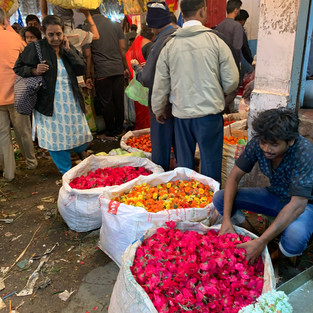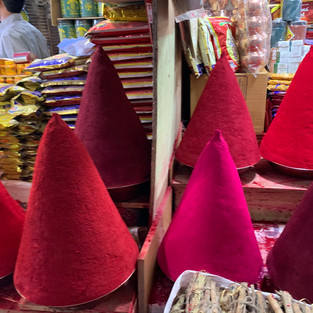Krishna Rajendra Market, Bengaluru, India.

Pastel pink filled the sky as the sun peeked above the horizon to the east. It was barely dawn, yet the market was already frantic. We had woken up in the early hours of the morning to explore Bangalore’s Krishna Rajendra Market. It was Republic Day and celebrations meant a busy morning for the flower traders.
The market sat in the basement of a three storey concrete building, spilling out onto the surrounding streets. An informal labyrinth of stalls wound their way through, each seller barracking themselves into a small pen using their goods. Men pushed past with heavy sacks on their shoulders, small children ran around barefoot on the confetti floor and women cradled heaps of buds against their intricate saris. It was noisy, rush hour had arrived, and there was no room for order. The tornado of colourful madness swept us up and we were soon carried along by the flow of people.
The tornado of colourful madness swept us up and we were soon carried along by the flow of people.
Eventually the maze opened out into a central hall. We climbed up a floor and looked down on the open space. Swarms of people filtered their way through the flowers below, dipping in and out of each colourful stall like bees pollinating a flowerbed. I lifted my camera and my focus drifted to a woman sitting amongst the commotion. The shutter clicked, blurring out the world around her. There were far fewer female sellers in the flower market, so she stood out amongst the other hawkers. India is still ranked one of the ten lowest countries for female workforce contribution and this inequality has stagnated for the past ten years. The lack of opportunities and support for the Backward and Scheduled Castes has left many women growing up illiterate and entering the informal economy unconsciously to earn a living, rather than make a career for themselves. Those that do make it into formal employment are often used as the workhorse for men in the same industry, doing mundane tasks for little money.
Even though female merchants may be rare, women do still have a major part to play in Bangalore’s flourishing floriculture. Karnataka is accountable for 75% of India’s flower production, and there are a total of 18,000 hectares of cultivated land in the region. On our trip, we had driven out of the city towards the Nandi Hills where many of these flowers originated. Row upon row of scarlet roses were being picked by women to be sold at the K.R. Market. These women worked long hours for approximately 500 Rupees (£5) a day in peak season, barely enough to live on, especially for those with a family.
The women that did work in the market either helped their husbands, or were kept out of sight on the higher floors, sat in groups and weaving approximately a kilo of roses and marigolds every half an hour for their husbands to sell. The finished garlands looked like snakes, coiled up in grand wicker baskets and when unravelled would stretch out for tens of metres. Depending on the season, they could be worth up to 200 Rupees per metre and would be snapped up by wedding planners or party organisers.
Unlike the other women haggling alongside their husbands, my subject sat alone. She looked up as a group of potential buyers approached her, leaning over to show off a coil of yellow chrysanthemums. Lifting the heavy basket with ease, our lady curled the flowers around her skinny wrist beside the other gold bangles that jingled on her arm. Female entrepreneurship at this low socio-economic level is frowned upon, yet in every way she could rival her male competition.
I lowered the camera and my eyes refocused on the bigger picture. I could not help but feel that India had a lot of work to do to readdress the gender balance. It would require a huge cultural shift to empower these women to step out on their own. Although this may be a long process it must start somewhere, as told in an old Indian Proverb “ All the flowers of tomorrow are in the seeds of today”.

How Tos
The K.R. Market opens between 2am and 10pm, but the best time to visit is before 7am to catch the flowers as they snapped up early. Get a tuk-tuk and then walk through the outdoor merchants to the main building. Start in the basement and wander around the corridors before finishing in the central hall. Make sure to climb up to the second floor for the best view.
To see the Nandi hills, we got a taxi and drove an hour and a half each way to the Bhoga Nandeeshwara temple. The drive takes you through small villages and the last half hour is through the cultivated land used for floriculture.
Top Tips
Wear long trousers and closed shoes around the K.R. Market. The ground is uneven and there is rubbish about so make sure to protect yourself. You may also find a thin scarf useful to cover your face walking to and from the market it can be quite polluted.
Take a decent camera and make the most of the fantastic colours, but keep valuables hidden when walking around. The market can be busy and you can get swept up easily in the crowd.
Although we did the trip by ourselves, there are a few walking tours available through independent guides such as Lonely Planet and Trip Advisor, which may be useful if you would like more information. However, we found just by talking to a few of the locals they are more than happy to tell you more about their work.
We struggled to find a tuk-tuk directly outside the market on the way home but walking a street or so away proved easier. The drivers can tell you are not a local and may try to charge more than the standard so do haggle the price down!











Kommentare